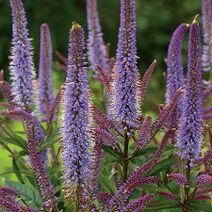Veronicastrum virginicum
| Veronicastrum virginicum | |
 | |
| Light: | |
| Moisture: | |
| Hardiness: | 3 |
| Soil pH: | 5.6-8.4 |
| Self Pollinated | |
| Height: | 4' |
| Width: | 1' |
| Blooms: | Mid Summer-Late Summer |
| Native to: | |
| Nectary | |
| Medicinal Rating: | |
| Tea: | Yes |
Veronicastrum virginicum (common names: beaumont's root and culver's root)
Propagation: Seed - sow autumn in a cold frame[1]. When they are large enough to handle, prick the seedlings out into individual pots and plant them out in the summer.
If you have sufficient quantity the seed can be sown outdoors in situ in the autumn or the spring.
Division in autumn or spring[1]. Larger divisions can be planted out direct into their permanent positions. We have found that it is best to pot up smaller divisions and grow them on in light shade in a greenhouse or cold frame until they are growing away well. Plant them out in the summer or the following spring.
Cultivation: Easily grown in a moderately fertile moisture retentive well drained soil[1]. Prefers cool summers[1]. Prefers a sunny position[2].
Hardy to at least -20°c[3].
Some named forms have been selected for their ornamental value[1].
Range: Eastern N. America - Ontario to Manitoba, south to Massachusetts, Alabama and Texas.
Habitat: Meadows, rich woods, thickets and prairies[4].
Medicinal: Beaumont's root was employed medicinally by several native North American Indian tribes who used it to treat a variety of complaints[5]. It is still occasionally used in modern herbalism, mainly for its effect upon the liver and bile production. Some caution is advised, the plant is potentially toxic[6].
The root is anodyne, cathartic, emetic, hepatic, laxative and tonic[7][8][9][10][11][6]. The fresh root is a violent cathartic and possibly emetic, the dried root is milder in its action, but less certain[7]. The root also gently excites the liver and increases the flow of bile[7][12]. An infusion has been used in the treatment of diarrhoea, coughs, chills and fevers, and also to ease the pain of backaches[5].
A tea made from the roots is strongly laxative[13][6]. The roots are harvested in the autumn and should be stored for at least a year before use[13].
Pollinators: Insects
Soil: Can grow in light, medium, and heavy soils.
Drainage: Prefers well drained soil.
Flower Type: Hermaphrodite
Also Known As: Leptandra virginica. Veronica virginica. L.
Links
References
- ↑ 1.0 1.1 1.2 1.3 1.4 Huxley, Anthony. The New Royal Horticultural Society Dictionary of Gardening. MacMillan Press, 1992.
- ↑ Brickell, Christopher. The RHS Gardener's Encyclopedia of Plants and Flowers. Dorling Kindersley Publishers, 1990.
- ↑ Phillips, Roger and Martyn Rix. Perennials - The Definitve Reference. Pan Books, 1991.
- ↑ Lyndon, Merritt. Gray's Manual of Botany. American Book Co, 1950.
- ↑ 5.0 5.1 Moerman, Daniel. Native American Ethnobotany. Timber Press, 1998.
- ↑ 6.0 6.1 6.2 Foster, Steven and Billy Tatum. Medicinal Plants of Eastern and Central North America. Houghton Mifflin, 1990.
- ↑ 7.0 7.1 7.2 Grieve, Margaret. A Modern Herbal. Penguin, 1984.
- ↑ Uphof, Johannes. Dictionary of Economic Plants. Weinheim, 1959.
- ↑ Usher, George. A Dictionary of Plants Used by Man. Constable, 1974.
- ↑ Mills, Simon. The Dictionary of Modern Herbalism.
- ↑ Duke, James and Edward Ayensu. Medicinal Plants of China. Reference Publications, 1985.
- ↑ Bown, Deni. Royal Horticultural Society Encyclopaedia of Herbs and Their Uses. Dorling Kindersley, 1995.
- ↑ 13.0 13.1 Weiner, Michael. Earth Medicine, Earth Food. Ballantine Books, 1980.